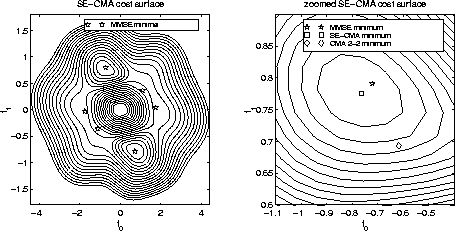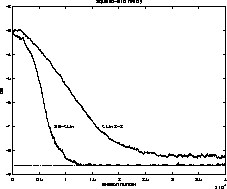


Next: 32-tap equalizer with 64-tap
Up: Simulation Results
Previous: Two-tap equalizer with four-tap
Again consider the communications system in Figure 1 with an i.i.d. BPSK source,
the (undermodeled) channel given by
![$\ensuremath{\mathbf{c}}=\left[\begin{array}
{cccccc}0.1&0.3&1&-0.1&0.5&0.2\end{array}\right]^T$](img38.gif) ,
and a two-tap FSE (Nf=2).
,
and a two-tap FSE (Nf=2).
Figure 4:
SE-CMA cost contours for undermodeled case with BPSK source, 15 dB SNR
 |
Figure 4 shows the SE-CMA cost contours
for this system when the SNR is 15 dB. Once again,
the SE-CMA minimum is closer to the MMSE minimum than is CMA 2-2.
For 40,000 iterations with
 , a portion of the squared-error history for a simulation
is shown in Figure 5 for a system with an SNR of 15 dB.
, a portion of the squared-error history for a simulation
is shown in Figure 5 for a system with an SNR of 15 dB.
Figure 5:
Comparison of error history for SE-CMA and CMA 2-2 (BPSK, 6-tap undermodeled channel)
 |
As shown, SE-CMA attains a lower error than CMA 2-2 in this undermodeled example as well.
Andrew Grant Klein
8/12/1998
![]() ,
and a two-tap FSE (Nf=2).
,
and a two-tap FSE (Nf=2).
![]() , a portion of the squared-error history for a simulation
is shown in Figure 5 for a system with an SNR of 15 dB.
, a portion of the squared-error history for a simulation
is shown in Figure 5 for a system with an SNR of 15 dB.